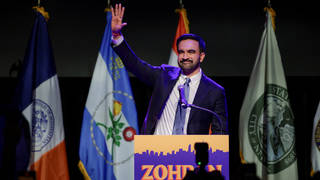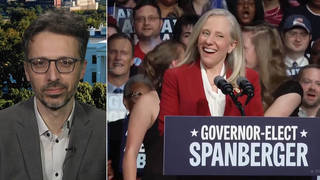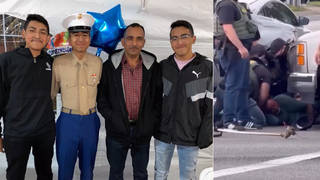
We go to Ciudad Juárez for an update on the fire that killed at least 38 men held at a Mexican immigration detention center just across the U.S. border from El Paso, Texas. Surveillance video from the jail shows guards walking away as flames spread inside the jail cells, making no effort to open the jail cells or help the migrants who were trapped. Mexican President Andrés Manuel López Obrador blamed the fire on the men who were being held at the detention jail, alleging that they set their mattresses on fire to protest conditions, while U.S. Ambassador to Mexico Ken Salazar claimed the tragedy was a consequence of “irregular migration.” The deaths in Mexico came just hours after the United Nations High Commissioner for Refugees urged the Biden administration not to adopt a proposed anti-asylum rule that would turn more refugees away at the border. We speak with the U.S.-Mexico border-based journalist Luis Chaparro.
Transcript
AMY GOODMAN: We begin today’s show in Ciudad Juárez, Mexico, where a fire has killed at least 38 migrants held in a Mexican immigration detention jail Monday night, injured dozens more. The fire occurred just across the U.S. border near the Santa Fe International Bridge to El Paso, Texas. Surveillance video from the jail shows guards walking away as flames spread inside the jail cells. In the video, guards made no effort to open the jail cells or help the migrants who were trapped.
Mexican officials initially said most of the dead were Venezuelans, but authorities in Guatemala say 28 of the victims were from Guatemala. Others killed and injured were from Venezuela, Honduras, El Salvador, Colombia and Ecuador.
On Monday night, a Venezuelan woman, who was holding her young child, talked about what happened to her husband, who was injured in the fire.
VIANGLY INFANTE: [translated] I have been waiting for their father since 1 p.m. They told me that they were going to hand him over to me. And then, at 10 p.m., we started to see smoke billowing from everywhere. Everybody ran away, but they left the men locked in. Everybody was removed from the area, but they left the men locked in. They never opened the door. …
We have the paperwork here in Ciudad Juárez, but they took him from the streets for no reason. They are taking us for no reason, without asking if we have the paperwork or not. If you are a migrant, they take you in the car. It’s that simple.
AMY GOODMAN: Speaking outside the jail, a Venezuelan man named Raniel Murillo decried the treatment of the men locked inside.
RANIEL MURILLO: [translated] To all of those people who died, the guards could have opened the gates to let them out, because there was only a few meters between the gate that separated them from the migration officers. They didn’t open the gate, leaving them locked in. The fire advanced, and they didn’t leave. The guards didn’t help them, because they didn’t feel like it. The guards treat you badly.
AMY GOODMAN: An official investigation into the fire has not been completed, but on Tuesday, Mexican President Andrés Manuel López Obrador said the fire began after migrants set their mattresses on fire to protest conditions. The United Nations Human Rights Office said the fire was a, quote, “preventable tragedy.” In a statement, the U.N. agency said, quote, “We, again, urge all States to adopt alternatives to immigration detention.”
We go now to Ciudad Juárez, Mexico, where we’re joined by Luis Chaparro, journalist reporting from the U.S.-Mexico border, where his new report for Vice News is just out. It’s headlined “'They Only Listen to Us When We Die': Migrants Killed in Fire Were Locked in Jail Cell.”
Welcome back to Democracy Now! It’s great to have you with us, Luis, but under horrible circumstances. Explain exactly what you understand happened, as you’ve talked to so many people there now since Monday night.
LUIS CHAPARRO: Hi, Amy and Juan. Thank you for having me.
And, yes, absolutely sadness that this happened in the world, Ciudad Juárez, although my opinion is that this is a tragedy that was due to happen. At the center of what happened 24 hours ago is — are these detention centers, that Mexico claims to be shelters but are no other than jails for immigrants, and that they have really done nothing but just being undocumented in a country that is a transit country for them.
And what goes behind those walls, we don’t really know, because these are very opaque and not transparent places, where we don’t have access as journalists or as NGOs. So we really don’t know what else is going on behind these bars. But judging by the video that was just out, when we see these cell guards and these immigration officers walking away like if nothing was happening, when flames were already out, show us, like — give us an example of what’s really going on behind those bars.
JUAN GONZÁLEZ: And, Luis, could you talk about — there have been some reports that the Mexican government, in the last few days especially, was cracking down increasingly on the asylum seekers, many of whom were forced to take odd jobs in the informal economy just to survive while they were waiting for a decision on their cases. Could you talk about that at all?
LUIS CHAPARRO: Definitely. And that’s — I think that’s what really began the whole tragedy. Most of the migrants from Venezuela, Guatemala, Honduras and El Salvador have really no place to stay, because shelters are at capacity. Some other shelters will only take families, if they have kids or women. And so, males, basically, are left out to sleep in the streets, in looted houses, and to beg or ask for money in stoplights around the city.
Many people in Ciudad Juárez began complaining for the presence of migrants out in the streets, and I think that pushed authorities to combine efforts, to call it one way, between the local police, state police and the Mexican Institute of Immigration, to crack down on people out in the streets. They started grabbing people from early in the morning. My understanding is that they started the raids from 10:00 in the morning all through the day.
They were locking migrants inside this facility with no water, no food, and they didn’t even understand why were they being locked up, since many of them actually had documents to be legally in the country for at least 30 more days. So, that’s why they started protesting inside the immigration center.
JUAN GONZÁLEZ: And could you talk about the significance of the fact that in a few weeks, in early May, there will be the end of the Title 42 policy in the United States as a result of a Supreme Court decision? There are reports that there are increasing numbers of migrants coming to the border. Do you expect these problems to increase over the next few weeks?
LUIS CHAPARRO: Most definitely. You know, the back-and-forth and all the confusion around immigration policies has been causing a tragic effect in the immigration community from different countries, because they are really confused. Like, the app they’re using, CBP One, is not working. We recently had a riot in one of the main ports of entry between Ciudad Juárez and El Paso, when migrants demanded that someone help them navigate the app, and they tried to get across to get help from CBP officers. So, that was just, you know, an example to how they feel frustrated and confused.
And now many of them are expecting for Title 42 to end, but they don’t really know if that’s actually going to happen, although they are arriving at border cities in hopes that Title 42 will end in May. But this is adding a lot of pressure to border cities like Ciudad Juárez and El Paso, and specifically to these institutes like the INM, the Mexican Institute for Immigration, that I don’t think they really have a capacity to work for and to this migrant community.
AMY GOODMAN: Luis, the deaths in Mexico came just hours after the United Nations High Commissioner for Refugees urged the Biden administration not to adopt the proposed anti-asylum rule that would deny claims made by refugees who lack, quote, “documents sufficient for lawful admission.” In a statement, the U.N. refugee agency said the regulation would restrict the fundamental human right to seek asylum, adding, quote, ”UNHCR is particularly concerned that … this would lead to cases of refoulement — the forced return of people to situations where their lives and safety would be at risk — which is prohibited under international law,” unquote. So, that’s the U.N.'s comment. So, if you can talk — while this is in Ciudad Juárez, it's literally feet from the border — about the responsibility of the U.S. government, as well, right now?
LUIS CHAPARRO: Definitely. This is one of the very notable examples of how these migrants are being endangered by these U.S. policies. The U.N. has been warning this for several years now, that these kind of policies are making migrants more and more vulnerable. One of the situations they face, of course, is violence by criminal organizations in Mexican soil. We’ve been seeing in places like Matamoros, places like Tijuana, as well, and Ciudad Juárez, that they’ve been targeted by criminal organizations to kidnap them, extort them and, in some other cases, to actually kill them.
And now we have this case, where it doesn’t only show you that they’re being targeted by criminal organizations or that they remain vulnerable to criminal organizations, but they also remain vulnerable to a very much corrupt and not transparent government, which is the Mexican government. And this is only happening because of the U.S. push to keep these policies in place, like Title 42, to name only one of the policies that are endangering migrants.
JUAN GONZÁLEZ: And, Luis, you mentioned the Mexican government. President López Obrador has increasingly in the past few months been striking a much more, I don’t want to say “militant,” but independent stance in many of his speeches against the United States. Yet, at the same time, he continues to cooperate, essentially, with first the Trump administration and now the Biden administration on the migration issue along the border. I’m wondering about the contradictions between López Obrador’s public statements and the practice of his government on this issue. I’m wondering if you could comment on that.
LUIS CHAPARRO: Sure. López Obrador says something and then does something else. And that’s been the policy since the beginning of his administration. When he said that Mexico was not going to be militarized, he completely militarized the country, also endangering migrants, because, as of right now, we have probably twice the National Guard members deployed to immigration tasks, the immigration enforcement tasks, than we have border patrol in both borders of the U.S. That says a lot about how the López Obrador administration is dealing with immigration, which is basically handing immigration tasks to former military and federal police officers that are not well prepared to deal with immigrants or with an immigration community.
López Obrador also has been trying to crack down the southern border of Mexico and also enforce the northern border of Mexico. So, even though if he’s been very, you know, active saying that he’s going to protect its own, he’s going to protect his country from U.S. policies that are harming Mexico, I think he has been doing absolutely the opposite, cracking down on immigration. This is probably the first administration that has been so harsh against immigrants in Mexican territory.
AMY GOODMAN: And comparisons to Trump, under the Trump years, Luis?
LUIS CHAPARRO: Yes. Well, in Trump years, actually, that’s when the Mexican administration began. I mean, López Obrador was pretty much complying with everything that former President Donald Trump was trying to do with Mexico. When he said that Mexico was going to pay for the wall, I think that was not literally, but mostly figurative. And I think that’s what López Obrador agreed upon, to build and make Mexico a jail for immigrants, in places like Tapachula, where we have probably even worse cases of these immigration detention facilities, but also by deploying hundreds and hundreds of National Guard members to the northern border, where they are literally grabbing migrants from doing something that is lawful, which is getting across and turning themselves over to Border Patrol agents to apply for political asylum.
AMY GOODMAN: Luis Chaparro, we want to thank you so much for being with us, as you speak to us from Ciudad Juárez in Mexico. We will link to your new report for Vice News, which is just out, “'They Only Listen to Us When We Die': Migrants Killed in Fire Were Locked in Jail Cell.”
Coming up, award-winning technology journalist Julia Angwin on why banning TikTok is not the answer. Stay with us.












Media Options